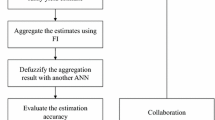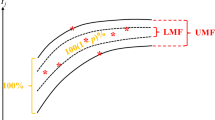Abstract
Predicting productivity is crucial in managing a factory. However, optimizing the precision of productivity prediction is not easy because two concerns must be addressed simultaneously: the hit rate and the average range. To enhance the precision of predictions of the productivity of a factory, a new fuzzy method is proposed in this paper. First, the hit rate and average range are merged into the cost for inclusion (CFI) to evaluate the precision of productivity prediction more reasonably. Subsequently, the CFIs of a traditional probabilistic method and four existing fuzzy methods are compared. According to the results of the comparison, the 100 (1 – α) % inclusion interval is used to reduce the CFI at the expense of a slight decrease in the hit rate. Subsequently, to improve the hit rate and CFI for testing and unlearned data, a selectively widened inclusion interval is adopted. Some theoretical properties of the proposed methodology are proven. In addition, data from two real cases, a dynamic random access memory (DRAM) factory and a wafer foundry, were used to illustrate the applicability of the proposed methodology. According to the experimental results, the wafer foundry exhibited a higher maturity level of productivity learning than the DRAM factory. In addition, the proposed methodology outperformed the existing probabilistic and fuzzy methods in minimizing the CFI (i.e., maximizing the precision). Further, the selectively widened inclusion interval was proven to be an effective means for trading the training performance for the testing performance.



























Similar content being viewed by others
References
Birgün S, Kahraman C, Gülen KG (2010) Fuzzy productivity measurement in production systems. In: Studies in fuzziness and soft computing, pp 417–430
Brandt L, Van Biesebroeck J, Zhang Y (2009) Creative accounting or creative destruction? firm-level productivity growth in Chinese manufacturing. NBER Working Paper Series, Working paper 15152
Ahluwalia IJ (1991) Productivity and growth in indian manufacturing. New Delhi
Coelli TJ, Rao DSP, O’Donnell CJ, Battese GE (2005) An introduction to efficiency and productivity analysis. Springer, Berlin
He YQ, Chan LK, Wu ML (2007) Balancing productivity and consumer satisfaction for profitability: statistical and fuzzy regression analysis. Eur J Oper Res 176(1):252–263
Chen T, and Wang YC (2013) Evaluating sustainable advantages in productivity with a systematic procedure. Int J Adv Manuf Technol (in press)
Wang YC, Chen T (2013) A fuzzy collaborative forecasting approach for forecasting the productivity of a factory. Adv Mech Eng 5:1–13
Chen T (2015) A fuzzy back-propagation network approach for planning actions to shorten the cycle time of a job in dynamic random access memory manufacturing. Neural Comput Appl 26(8):1813–1825
Sangaiah AK, Subramaniam PR, Zheng X (2015) A combined fuzzy DEMATEL and fuzzy TOPSIS approach for evaluating GSD project outcome factors. Neural Comput Appl 26(5):1025–1040
Lamb T, Hellesoy A (2002) A shipbuilding productivity predictor. J Ship Prod 18(2):79–85
Han S, Halpin DW (2005) The use of simulation for productivity estimation based on multiple regression analysis. In: Proceedings of the 2005 winter simulation conference, pp 1492–1499
Zayed TM, Halpin DW (2004) Quantitative assessment for piles productivity factors. J Constr Eng Manag 130(3):405–414
Chen T, Wang YC (2013) Semiconductor yield forecasting using quadratic-programming based fuzzy collaborative intelligence approach. Math Probl Eng 2013:1–7
Chen T (2012) A hybrid fuzzy and neural approach with virtual experts and partial consensus for DRAM price forecasting. Int J Innov Comput Inf Control 8(1B):583–598
Alvarado-Iniesta A, García-Alcaraz JL, Piña-Monarrez M, Pérez-Domínguez L (2014) Multiobjective optimization of torch brazing process by a hybrid of fuzzy logic and multiobjective artificial bee colony algorithm. J Intell Manuf. doi:10.1007/s10845-014-0899-2
Deming WE (1986) Quality, productivity, and competitive position. Massachusetts Institute of Technology, Cambridge
Rathore A, Mohanty RP, Lyons AC, Barlow N (2005) Performance management through strategic total productivity optimization. Int J Adv Manuf Technol 25(9–10):1020–1028
Chen T (2007) Evaluating the mid-term competitiveness of a product in a semiconductor fabrication factory with a systematic procedure. Comput Ind Eng 53:499–513
Chen T (2010) A FNP approach for establishing the optimal and efficient capacity re-allocation plans for enhancing the long-term competitiveness of a semiconductor product. Int J Fuzzy Syst 12(2):158–169
Chen T (2010) Establishing the optimal and efficient capacity re-allocation plans for enhancing the long-term competitiveness of a semiconductor product: a long-term trend viewpoint. Proc Inst Mech Eng B J Eng Manuf 224:1295–1303
Kovac P, Rodic D, Pucovsky V, Savkovic B, Gostimirovic M (2013) Application of fuzzy logic and regression analysis for modeling surface roughness in face milling. J Intell Manuf 24(4):755–762
Tanaka H, Uejima S, Asal A (1982) Linear regression analysis with fuzzy model. IEEE Trans Syst Man Cybern SMC-12(6):903–907
Peters G (1994) Fuzzy linear regression with fuzzy intervals. Fuzzy Sets Syst 63:45–55
Donoso S, Marin N, Vila MA (2006) Quadratic programming models for fuzzy regression. In: Proceedings of international conference on mathematical and statistical modeling in honor of enrique Castillo
Atalay KD, Eraslan E, Çinar MO (2015) A hybrid algorithm based on fuzzy linear regression analysis by quadratic programming for time estimation: an experimental study in manufacturing industry. J Manuf Syst 36:182–188
Mashinchi MH, Orgun MA, Mashinchi M, Pedrycz W (2011) A Tabu–harmony search-based approach to fuzzy linear regression. IEEE Trans Fuzzy Syst 19(3):432–448
Wang H, Guo S, Yue L (2014) An approach to fuzzy multiple linear regression model based on the structural element theory. Syst Eng-Theory Pract 34(10):26–28
Chen T, Chiu MC (2015) An improved fuzzy collaborative system for predicting the unit cost of a DRAM product. Int J Intell Syst 30:707–730
Zolfaghari ZS, Mohebbi M, Najariyan M (2014) Application of fuzzy linear regression method for sensory evaluation of fried donut. Appl Soft Comput 22:417–423
Author information
Authors and Affiliations
Corresponding author
Appendix
Appendix
1.1 LP Model I
subject to
1.2 QP Model I
subject to
1.3 QP model II
Rights and permissions
About this article
Cite this article
Chen, T. New fuzzy method for improving the precision of productivity predictions for a factory. Neural Comput & Applic 28, 3507–3520 (2017). https://doi.org/10.1007/s00521-016-2270-3
Received:
Accepted:
Published:
Issue Date:
DOI: https://doi.org/10.1007/s00521-016-2270-3




